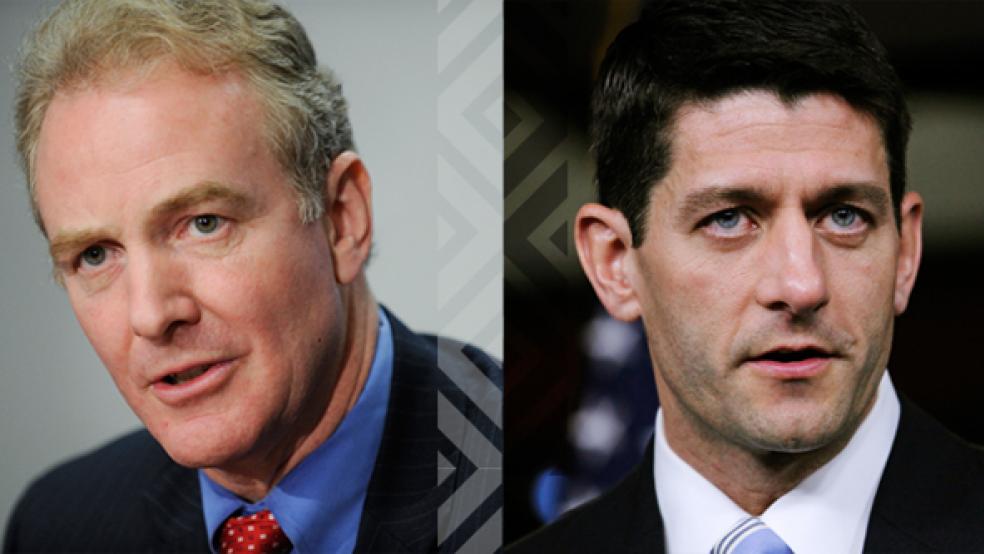The Republican House is set to pass a massive fiscal 2013 budget, tax and entitlement blueprint today after rejecting a handful of alternatives, including one offered by the chief Democrat on the House Budget Committee.
The GOP plan crafted by House Budget Committee Chairman Paul Ryan of Wisconsin calls for a major overhaul of the federal tax code, deep cuts in domestic spending, and the long term elimination of Medicare and Medicaid as we know it. It is the GOP response to the budget plan unveiled by President Obama earlier this year. And while it has no chance of making it past the Senate or becoming the guiding principles of Congress, Ryan’s plan will get plenty of attention this fall on the campaign trail, as Republicans and Democrats square off over fiscal policies and the deficit.
RELATED: Ryan’s New Budget Overhauls Medicare and Taxes
The Democratic alternative drafted by Rep. Chris Van Hollen of Maryland is more in line with the Obama administration’s approach. It preserves basic entitlement programs, makes more modest long-term cuts to programs, requires wealthier Americans to bear a greater share of the tax burden, and takes far longer to balance the budget.
Other proposals that were considered but given short shrift were the budgets of the conservative House Republican Study Committee and the Progressive Caucus and an amendment by Reps. Jim Cooper of Tennessee and Steven LaTourette of Ohio that embraces many of the provisions of the Bowles-Simpson presidential debt commission.
The Fiscal Times sifted through the contents of the competing Ryan and Van Hollen plans to assess what they would mean for the federal government and average Americans – and here’s what we found:
ON TAXES
The Ryan plan takes a hatchet to the current tax code, while Van Hollen leaves most of the current structure in place, with a few revenue-enhancing tweaks.
Ryan’s plan would permanently extend all the Bush-era tax cuts, repeal tax provisions in the health care reform law, end the Alternative Minimum Tax, lower the top corporate tax rate to 25 percent from 35 percent, and nearly eliminate U.S. taxes on American corporations’ earnings from overseas operations. He would also shrink the individual tax code from six brackets down to two of 10 and 25 percent.
Ryan says his tax proposals would be revenue neutral, meaning the overall cost would be offset by eliminating other costly tax breaks and loopholes. However, he has declined to mention any likely targets, such as the home mortgage interest deduction or the tax break on employer-provided health care — two of the largest tax expenditures. Ryan said it would be up to the tax-writing House Ways and Means Committee to decide. With the details currently available, the Tax Policy Center estimates his plan would drain the Treasury of about $4.6 trillion by 2022.
Van Hollen’s plan, by contrast, extends the Bush-era tax cuts for all families except those earning over $1 million. To raise revenue, Van Hollen would institute what Obama has called “the Buffett Rule,” or an alternative minimum tax of 30 percent levied on anyone earning more than $1 million a year. That change would raise $47 billion in revenue over the next decade, according to the Joint Committee on Taxation.
He also endorses the tax reform blueprint the Obama administration released last month, which calls for slashing the top corporate tax rate to 28 percent from 35 percent by scrubbing the vast majority of the more than 130 tax preferences businesses currently enjoy. Tax breaks for domestic manufacturers, company research and development, and clean energy firms would be the only ones spared. Meanwhile, companies accustomed to stashing profits earned overseas into various low-tax jurisdictions would be forced to pay a minimum tax on those profits—although neither Van Hollen nor the White House has specified the rate.
SPENDING CUTS
Where Van Hollen’s plan targets tax breaks for companies and high-earners to rein in the nation’s deficits and debt, Ryan’s targets total federal spending.
Setting a $1.028 trillion discretionary spending cap for fiscal 2013, Ryan’s plan would alter last summer’s debt ceiling compromise by cutting programs by an additional $19 billion and installing a framework to curb Medicare and Medicaid spending. Over the next ten years, Ryan says his proposals would cut debt as a share of the U.S. economy to 1.2 percent — or 15 percent lower than current levels. Deficits and the national debt, however, would not fully vanish until 2040 under his approach.
By contrast, Van Hollen’s plan retains the $1.047 trillion discretionary spending level for the coming year agreed to in August’s compromise. He wholly rejects Ryan’s spending cut proposals, andendorses Obama’s calls for tens of billions of dollars of new short-term spending to spur jobs in education, police and fire departments, and highway infrastructure projects. He also leaves Medicare, Medicaid, and Social Security intact. Instead of changing those entitlements, his plan would derive savings from billions of dollars in cuts to farm subsidies and military spending, along with the aforementioned tax increases on the wealthy. Van Hollen says his plan would cut the deficit from 8.1 percent GDP in 2012 down to 2.7 percent in 2022. It sets no time frame for balancing the federal budget.
HEALTH CARE AND ENTITLEMENTS
Perhaps the starkest contrast between the two plans comes in their competing ideas for how to contend with the growing costs of health care for the elderly and poor.
Ryan proposes repealing Obama’s signature health care law and overhauling Medicare, Medicaid, and cutting back other entitlement health spending programs. Over ten years, his plan cuts Medicare by $205 billion, and Medicaid and smaller health programs by $770 billion.
To accomplish that, he would keep the current Medicare system intact for current seniors but would gradually hike the eligibility age from 65 to 67. Workers younger than 55 would receive a government payment to either apply toward private insurance or to a government-run program similar to today’s Medicare. As for Medicaid, the federal government would no longer pay a fixed portion of states’ costs and would instead provide them a fixed dollar amount to be indexed annually for inflation and population growth. Food stamp, welfare, and farm subsidy programs would be cut by about $2 trillion.
Van Hollen’s proposal, on the other hand, largely leaves Medicare and Medicaid untouched, and defers to cost-saving provisions of Obama’s health care law to control Medicare costs for seniors.





